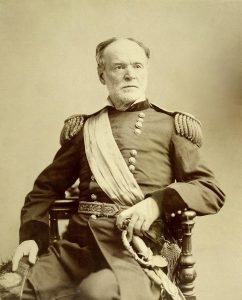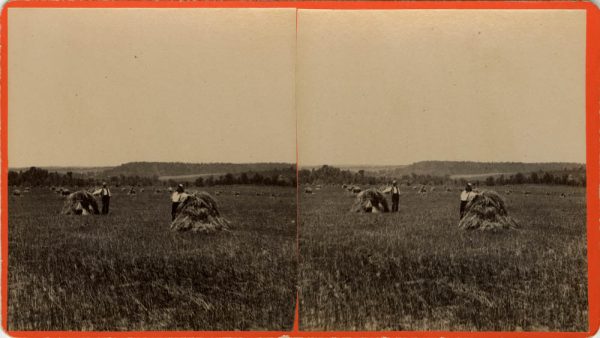Sherman’s Visit to the Wilson’s Creek Battlefield in 1885

ECW welcomes back guest author Kristen M. Pawlak
Ever since the guns were silenced in the spring of 1865, veterans and civilians alike trek the battlefields of the Civil War to inspire them and understand the carnage and sacrifice that occurred on those hallowed fields. Learning about what happened at these locations and why it matters is one of the most meaningful ways to honor soldiers of the Civil War – even the veterans themselves said that.
One of those veterans was William T. Sherman, the great, but controversial, commander of the Federal military division that captured Atlanta, marched through Georgia and the Carolinas, and forced the surrender of Johnston’s Army of Tennessee at Bennett Place. After the war, he continued to serve in the United States Army as its Commanding General until 1883.
Having lived in Missouri – specifically in St. Louis – in the years before the Civil War, Sherman had a close relationship with Missouri veterans, particularly fellow West Pointers and career soldiers he served with in the Army before, during, and after the Civil War. In 1885, Sherman “desired to visit the battlefield of Wilson’s Creek and the spot where Gen. Lyon fell.” To Sherman, who knew him personally before the war, Lyon “was somewhat careless in dress and manner, but intensely earnest in his ways, thoughts, and expressions … personally brave to a fault, not very social or friendly, yet honest and fearless.” Though Sherman served at another early-war battle, Manassas, he still wished to walk in the footsteps of a fellow Union war hero.
In the July 16, 1885 issue of The National Tribune, the chief newspaper for Union veterans and the Grand Army of the Republic, Sherman recalled his visit to Wilson’s Creek on Decoration Day that year:
“As I remarked, I desired to look over the ground, and the gentlemen and ladies of Springfield afforded me the best possible opportunity. Quite a large party in carriages and buggies were ready on Sunday morning, May 31, and under the guidance of one who was in the battle and was familiar with the county, we drove down by the route taken by Sigel, – viz., that east of Wilson’s Creek; but the road is much changed by the farmers, who compel the new road to follow their fence lines. Still, by a drive of about 12 miles through a well-cultivated country, we reached the valley of Wilson’s Creek near the spot where the rebel General Price had his headquarters, forded the stream and ascended a sharp hill, quite stony with the universal limestone of that region, to a plateau overlooking the whole valley, where was pointed out a pile of stones marking the spot where Lyon’s dead horse was found, and an oak tree notched to mark the spot where Lyon himself was killed.
A simple glance over the field satisfied me that neither McCullough [sic] or Price chose that position on which to fight a battle, and that they simply halted their army there by reason of the convenience of “wood, water and grass,” intending thence, by one short march of 12 miles, to engage Lyon’s forces in or near Springfield. In like manner Lyon, having resolved to be the attacking instead of the attacked party, availed himself of night and the fringe of trees which over the hills and breaks of both sides of Wilson’s Creek, to conceal his movement till his guns and rifles would produce confusion, disorder, and rout to his ill-disciplined enemy…
Still, war is a desperate game, wherein often the most rash and hasty resolves often win, when prudence and canton fail; so I much not be construed as a critic of the battle of Wilson’s Creek. I believe Gen. Lyon did what he supposed right; he lost his life and is entitled to our praise and gratitude.

I know he did much to save Missouri to the National cause, and I believe Missouri was then and still is essential to the perpetuity of the Union…
The ladies and gentlemen who took us to the battlefield, mindful of our creature wants, had carried in their carriages baskets, which, when unpacked on clean linen tablecloths in the shade of trees which were saplings when Lyon died, made a feast that satisfied us all, and furnished plenty to people who had come there knowing of our intended visit.
Toward evening, we drove back to Springfield by the route of Lyon’s march to the battle, via west of Wilson’s Creek, varied of course by the many “turnouts” caused by farmers forcing the roads to go around their farms.
For their sakes, I pray that war may not come again to Southwest Missouri, for I am sure soldiers will never march around a field when they can cut across.”
Just like it is today, touring battlefields allows us historians to see the battlefield as the soldiers saw and experienced combat. We better understand the actions, decisions, and experiences of commanders and soldiers alike when we walk the fields like Sherman did in 1885. Due to the efforts of dedicated preservationists, we, too, can see what they saw and understand the battles in their own perspective. It is truly a remarkable thing.
Kristen M. Pawlak is the Development Associate for Stewardship at the Civil War Trust. She also sits on the Board of Directors at the Missouri Civil War Museum, and actively volunteers with the Marine Corps Scholarship Foundation. She graduated from Gettysburg College in 2014 with a BA in History and Civil War Era Studies, and is currently pursuing her MA in Nonprofit Leadership and Management at Webster University. From St. Louis, Kristen has a fond interest in the Civil War in Missouri, Civil War medicine, and the war experiences of soldiers.
Source:
William T. Sherman, “At Springfield on Decoration Day,” The National Tribune, July 16, 1885.
Thank you for sharing this story, because until reading I had no appreciation of a connection between Nathaniel Lyon and W.T. Sherman. Of interest, General Sherman in his Memoirs makes scant mention of Lyon (unlike Ord and Halleck, who are frequently recorded.) Yet, all four men served together at West Point, and were together for a number of years (1849 – 1851) in California.
What was it, really, that took Sherman to Wilsons Creek? Concern for the memory of a neglected school chum? Or the opportunity to “take in the scenery” at a battle ground with experience similar to one where Sherman fought and bled: this one, Wilsons Creek, claimed the life of the Federal commander. Sherman’s close call was at Shiloh.
[There, but for the Grace of God, go I.]
Hi Mike,
Thanks for commenting! You bring up some interesting points regarding Sherman’s visit and his relationship with Nathaniel Lyon. Though he did not fight in the Battle of Wilson’s Creek, Sherman’s connection with Missouri (residing in St. Louis before the war) may have sparked his interest to visit this battlefield.
In the wake of his death at Wilson’s Creek, Lyon was revered by many who knew him, specifically being the first Union general to die in the war. Even Thomas L. Snead, Price’s Chief of Staff, thought of Lyon as one of the bravest soldiers he ever knew. So, there are many reasons why Sherman would have visited the battlefield, just as you have said. We could undoubtedly name more reasons.
Thanks again for sharing your thoughts, Mike!
– Kristen M. Pawlak
Interesting read; thank you.